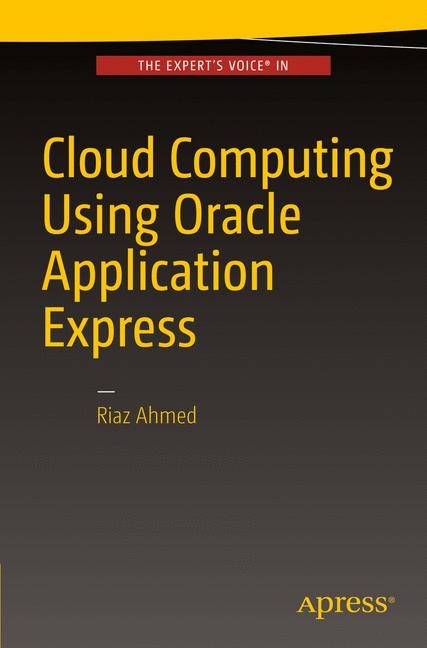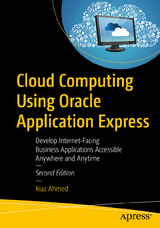
Cloud Computing Using Oracle Application Express
Apress (Verlag)
978-1-4842-2501-1 (ISBN)
- Titel erscheint in neuer Auflage
- Artikel merken
Cloud Computing Using Oracle Application Express will teach you how to develop a complete general ledger accounting system which will be accessible through a variety of devices, including desktops, laptops, and the latest smartphones.
What You Will Learn:
Use new Oracle APEX 5.0 techniques
Develop a complete general ledger accounting system named The Cloud Accountant
Create cloud-based business apps accessible anywhere and anytime
Enhance your APEX development skills
Who This Book Is For:
Web developers who possess some working knowledge of Oracle Application Express, and developers who have been using Oracle Forms and now wish to use their existing SQL and PL/SQL expertise.
Author Bio for the FM: Riaz Ahmed is an IT professional with more than 23 years experience. He started his career in early 90's as a programmer, and has been employed in a wide variety of information technology positions, including analyst programmer, system analyst, project manager, data architect, database designer and senior database administrator. Currently he is working as head of IT for a group of companies. His core areas of interest include web-based development technologies, business intelligence, and databases. Riaz possesses extensive experience in database design and development. Besides all versions of Oracle, he has worked intensively in almost all major RDBMS on the market today. During his career he designed and implemented numerous databases for a wide range of applications, including ERP.
Chapter 1: Introduction to Cloud Computing and Application Project 1The book focuses on developing business applications for the cloud and provides step by step guidance in developing a financial accounting system to give you a taste of cloud computing with respect to building business applications in Oracle APEX. This chapter provides an overview of cloud computing and the application project.
Chapter 2: Application Navigation 9First of all you will be guided through the creation of a navigation structure for the application including its menus, submenus, and a navigation bar. Using this structure, users can access different segments of the application according to their respective privileges, which is granted to them by the application administrator.
Chapter 3: Companies 13The application is capable of maintaining accounts of multiple companies simultaneously. This setup allows you to create as many companies as you need. Each company is provided with a unique code that distinguishes its transactions from that of the others.
Chapter 4: Fiscal Year 15Each company created in the application must have a fiscal year to keep records of its financial proceedings. You can create different fiscal years for different companies. However, this book follows a fiscal year which starts from 1st July and ends on 30th June.
Chapter 5: Voucher Types 25You can create multiple voucher types to record financial transactions. This approach is handy to distinguish between transactions of various natures. For example, you can create two different voucher types to record payments made through cash and bank.
Chapter 6: Application Segments 29You will create a robust security module for this application to control its access. The application consists of several segments that need protection from unauthorized access. In this chapter you will spot all those segments which will be utilized in the next chapter to handle the application security.
Chapter 7: User Groups 35Assigning application access privileges to individual users is not an easy task, especially when they are in large numbers and belong to different positions. To make things simple, you will create a few groups, each of which will be granted different application privileges. Then you will create individual user accounts and assign them a group. Using this approach the users inherit their privileges from the group they belong to.
Chapter 8: Create Users 43In this chapter you will create the application users. Each user is associated with a group and is assigned to a company. After making a successful log-in attempt, the application provides the users with the privileges of the group they belong to allowing them to maintain the accounts of the company assigned to them.
Chapter 9: Reset Password 47The application stores encrypted password for each user. The interface created in this chapter will be used to set initial passwords for all application users. The same interface is provided to the users (with fewer privileges) so that they can change their own passwords when they want to.
Chapter 10: Switch Company, Year and Month 53Different users in the application are granted different privileges. Some users are allowed to maintain accounts of multiple companies, while some are restricted to handle just one company. The former group of users can switch to other companies, years, and fiscal periods from this interface.
Chapter 11: Cost Centers 57Cost conscious organizations always keep both eyes on their expenses. With the help of a two level cost center setup you allow them to keep track of all costs incurred on different departments in different locations.
Chapter 12: Chart of Accounts 63Financial accounting applications follow a pre-defined accounts list which is called the chart of account. It is created to maintain accounts in an organized manner. In this chapter you will create an interface where users will create a chart of account comprising four levels for each company.
Chapter 13: Copy Chart of Accounts 71The Copy Chart of Accounts utility is provided to avoid the labor involved in creating a chart of account for each company individually. It will allow the application administrator to copy an existing (master) chart of accounts to all companies created in the application.
Chapter 14: Enter Vouchers 75After completing the setup phase, you create an interface to record business transactions. This interface is called a Voucher, where you select a type, provide a number, select a date, enter a description, pick accounts and cost centers from their respective setups, and enter debit and credit figures. It is a real time process. Once you save a voucher, all financial reports in the application are updated immediately.
Chapter 15: Search Transactions 85It’s a routine work for an accountant to search for a transaction recorded in the past. In this chapter you will create a utility which searches transactions for a user-specified criterion.
Chapter 16: Vouchers Verification 89This interface is created for authorized users to verify vouchers created by data entry clerks. Once a voucher is marked as verified, no one can manipulate it unless the authorized person reverses its state to unverified.
Chapter 17: Vouchers Report 95It is a usual accounting practice to print vouchers after creation. This chapter will teach you how to create parameterized group reports with custom layouts.
Chapter 18: Ledger Report 103In this application you will create some generic financial reports. The ledger report is one of them which provide details of an account in a tabular form. To get this report, the user must provide a couple of parameters comprising account range and duration.
Chapter 19: Trial Balance Report 109The trial balance report presents opening, activity, and closing balances of accounts in a tabular form. You can generate this report for a specific cost center and for a selected level.
Chapter 20: Opening Bank Transactions 117You will next enable the accountant to reconcile his ledger transactions with his bank. This is the first step in the bank reconciliation process where the accountant records all bank transactions which remained unreconciled prior to starting this application.
Chapter 21: Bank Reconciliation 121This is the interface which you provide to the accountant for bank reconciliation. Besides the transactions entered through vouchers, this interface contains a region to display opening unreconciled transactions, recorded in the previous chapter.
Chapter 22: Bank Reconciliation Report 127After reconciling ledger transactions with the bank statement, the accountant generates this report which shows the remaining unreconciled transactions and balances as per ledger and bank statement.
Chapter 23: Month Closure 131In the application the fiscal year of a company comprises twelve periods. All transactions are recorded in their respective periods. After recording all transactions in a period it can optionally be marked as closed to prevent data manipulation.
Chapter 24: Year End Processes 135The yearend process comprises two options: Temporary and Permanent. The former process generates a new fiscal year and transfers closing balances of accounts to the new fiscal year. The permanent closing process marks a year as permanently closed. After executing the TYE process you can manipulate data in all open months of that year, whereas the PYE process doesn’t allow any kind of data manipulation.
Chapter 25: Budget Allocation 141By allocating budgets for accounts an accountant can keep things under control. You will allow the accountant to allocate budget in three ways: manual, last year actual, and last year budget.
Chapter 26: Budget Report 147After allocating a budget to an account its value is compared with the actual amount spent and the variance between these figures is reported in the budget report.
Chapter 27: Setup Accounts for Financial Statements 153In this chapter you will create an interface where users will define accounts (from the chart of accounts) to produce the two most common financial statements: Profit & Loss and Balance Sheet.
Chapter 28: Financial Statements 159The accounts defined in the previous chapter are used here to generate the two financial statements. These two statements reveal the financial health of an organization.
Chapter 29: Executive Dashboard 169The executive dashboard comprises several charts. This graphical representation reveals the financial status of the organization to interested parties.
Chapter 30: Application Feedback 175The application feedback is a feature which is added to allow interaction between the application users and its administrator.
Chapter 31: Mobile Version 179In this chapter you will create some high-end graphical financial reports for the busy business community to keep them in touch with their businesses wherever they go.
Chapter 32: Application Security 189After implementing a custom authentication scheme in chapters 7, 8, and 9 your next task is to implement the authorization policy. In this chapter you will create some authorization schemes to protect the application menus, pages, buttons, and processes.
Chapter 33: Appendix 199The file available at http://www.creating-website.com/Book_Code.rar contains all source code used in this book. To facilitate you further, the appendix section lists the code as a handy reference. Please note that the file name (Book_Code.rar) is case sensitive.
| Erscheinungsdatum | 23.12.2016 |
|---|---|
| Zusatzinfo | 417 Illustrations, color; 19 Illustrations, black and white; XXV, 403 p. 436 illus., 417 illus. in color. |
| Verlagsort | Berkley |
| Sprache | englisch |
| Maße | 155 x 235 mm |
| Gewicht | 6496 g |
| Themenwelt | Informatik ► Datenbanken ► Oracle |
| Mathematik / Informatik ► Informatik ► Netzwerke | |
| Mathematik / Informatik ► Informatik ► Web / Internet | |
| Schlagworte | accounts • Application Navigation • Cloud Computing • Cost Centers • Oracle • Oracle Application Express • Oracle Applications • Search Transactions • User Groups |
| ISBN-10 | 1-4842-2501-5 / 1484225015 |
| ISBN-13 | 978-1-4842-2501-1 / 9781484225011 |
| Zustand | Neuware |
| Informationen gemäß Produktsicherheitsverordnung (GPSR) | |
| Haben Sie eine Frage zum Produkt? |
aus dem Bereich


